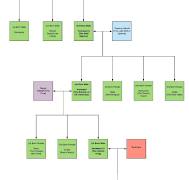Mastering Your Ancestry: Lucidchart Family Tree Unveiled
The Lucidchart Family Tree: Unveiling Your Ancestral Connections
Genealogy enthusiasts and family historians alike are constantly seeking innovative tools to map out their family trees with precision and clarity. One such tool that has gained significant popularity in recent years is the Lucidchart Family Tree.
Lucidchart offers a user-friendly platform that allows individuals to create detailed and visually appealing family trees. With its intuitive interface and customizable features, users can easily input names, dates, relationships, and other relevant information to construct a comprehensive family history.
One of the key advantages of using Lucidchart for building your family tree is its collaborative nature. Users can invite family members to contribute their knowledge and insights, making it a shared project that strengthens familial bonds and uncovers hidden connections.
Furthermore, Lucidchart provides various templates and design options to suit different preferences and styles. Whether you prefer a traditional layout or a more modern design, the platform offers flexibility to customize your family tree according to your vision.
In addition to its visual appeal, Lucidchart also serves as a practical tool for organizing genealogical data. By structuring information in a clear and logical manner, users can easily navigate through generations, identify patterns, and uncover missing pieces in their family history puzzle.
Overall, the Lucidchart Family Tree stands out as a versatile and user-friendly solution for individuals looking to document their ancestry in a visually engaging format. With its collaborative features, customization options, and organizational capabilities, Lucidchart empowers users to delve deep into their roots and preserve their familial legacy for future generations.
Top 7 FAQs About Creating Family Trees with Lucidchart
- What is the best chart for a family tree?
- What is the best free Family Tree Maker?
- How do I diagram a family tree?
- Is there a template for a family tree?
- What is the best website to draw a family tree?
- How do you use Lucidchart for genealogy?
- How to make a family tree in Lucidchart?
What is the best chart for a family tree?
When considering the best chart for a family tree in Lucidchart, it ultimately depends on personal preference and the complexity of the family history being documented. Some users may prefer a traditional pedigree chart for a straightforward display of direct ancestors, while others might opt for a fan chart to showcase multiple generations in a visually appealing layout. Descendant charts are ideal for tracing lineage through offspring, while hourglass charts can provide a comprehensive view of both ancestors and descendants. The key is to choose a chart format that effectively conveys the desired information and aligns with the user’s genealogical goals and storytelling style.
What is the best free Family Tree Maker?
When it comes to selecting the best free Family Tree Maker, Lucidchart often emerges as a popular choice among genealogy enthusiasts. With its user-friendly interface, collaborative features, and customizable templates, Lucidchart offers a comprehensive solution for creating detailed family trees at no cost. The platform’s versatility and ease of use make it an attractive option for individuals looking to map out their ancestral connections with precision and clarity. By leveraging the strengths of Lucidchart’s free Family Tree Maker, users can embark on their genealogical journey with confidence and creativity, ensuring that their family history is documented and preserved in a visually engaging format.
How do I diagram a family tree?
To diagram a family tree using Lucidchart, start by creating a new document and selecting a template that best fits your vision for the layout of your family tree. Begin by adding yourself as the main individual and then branch out to include your parents, siblings, grandparents, and so on. Use connectors to indicate relationships between family members and add relevant information such as names, birthdates, marriage dates, and any other significant details. Customize the design of your family tree by adjusting colors, fonts, shapes, and styles to make it visually appealing and easy to follow. Utilize the collaborative features of Lucidchart to invite family members to contribute their knowledge and insights, making it a shared project that captures the richness of your familial connections.
Is there a template for a family tree?
When users inquire about whether there is a template available for a family tree on Lucidchart, the answer is a resounding yes. Lucidchart offers a variety of customizable templates specifically designed for creating family trees. These templates provide users with a solid foundation to start mapping out their ancestral connections efficiently and effectively. By utilizing these pre-designed layouts, individuals can streamline the process of inputting names, relationships, and other vital information, allowing them to focus more on exploring their family history and less on formatting. With the convenience of ready-made templates, users can jumpstart their genealogical journey with ease and clarity using Lucidchart’s intuitive platform.
What is the best website to draw a family tree?
When it comes to creating a family tree online, one commonly asked question is, “What is the best website to draw a family tree?” Among the various options available, Lucidchart often emerges as a popular choice for individuals seeking a user-friendly and visually appealing platform to map out their ancestral connections. With its intuitive interface, collaborative features, and customizable templates, Lucidchart offers users a comprehensive tool to create detailed and organized family trees. Whether you are a beginner in genealogy or an experienced researcher, Lucidchart provides the flexibility and resources needed to bring your family history to life in a clear and engaging manner.
How do you use Lucidchart for genealogy?
Utilizing Lucidchart for genealogy involves a straightforward and efficient process that empowers users to create detailed family trees with ease. To begin, users can start by inputting key information such as names, dates, and relationships of their ancestors into the Lucidchart platform. By utilizing the intuitive interface and customizable features, individuals can organize their genealogical data in a structured and visually appealing manner. Additionally, users can take advantage of the collaborative nature of Lucidchart by inviting family members to contribute their knowledge and insights, making it a collective effort to uncover ancestral connections. With its diverse templates and design options, Lucidchart provides flexibility for users to personalize their family trees according to their preferences and styles. Overall, using Lucidchart for genealogy offers a comprehensive toolset that streamlines the process of documenting and visualizing one’s family history in a clear and organized format.
How to make a family tree in Lucidchart?
To create a family tree in Lucidchart, start by opening a new document and selecting a template that suits your preferences. Begin by adding the main individual (usually yourself or the oldest known ancestor) at the top of the chart. Then, gradually expand the tree by adding parents, siblings, spouses, and children, connecting each member with appropriate lines to indicate relationships. Utilize Lucidchart’s drag-and-drop feature to easily rearrange and customize the layout of your family tree. Include relevant details such as names, birthdates, and other significant information to enrich your genealogical record. Collaborate with family members by sharing the document and inviting them to contribute their knowledge and insights. Finally, remember to save your work periodically to ensure that your family tree is securely stored and easily accessible for future reference.

